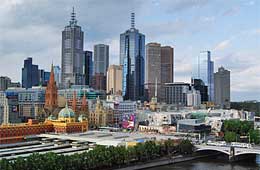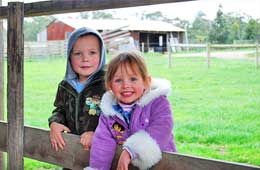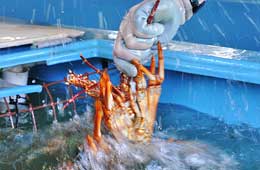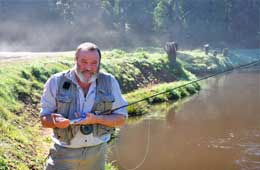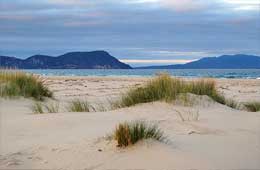The Age
The gap is slowly closing for disadvantaged Koorie students with a larger number of enrolments from three and four-year-old kindergarten through to secondary level, a record proportion of Year 12 completers continuing to university, and a year seven to 10 school retention of almost 100 per cent. There is, however, still room for further improvement particularly in Gippsland. Absenteeism among indigenous students in Gippsland has improved in recent years but still remains higher than among non-indigenous students.
The Gippsland town of Drouin has always had a firm Koorie community where 24 of 250 students attend Drouin Primary School and 26 of 970 students attend Drouin Secondary College.
Mr Shane Wainwright, Principal of Drouin Secondary College and Mr Brad Wheller, Principal of Drouin Primary School agree that although they are in a much better situation than they were several years ago, the absentee rate is still higher among indigenous students than non-indigenous students. Mr Wainwright said their success rate of getting Koorie students through to year 12 would also be lower in terms of retention than the average, but that the issues around indigenous education are complex.
He said the Education Department have recognised that Koorie students are disadvantaged and as such have targeted funding to support them. “Part of that has been Wannik funding to support Koorie students with lower numeracy and literacy levels, so we have tutors that support them. We also have a homework club that meets once a week for our Koorie students and funding has been used for that. While the target for funding this year is for younger primary students, we will still endeavor to provide that support.”
Mr Wheller said over the last few years there’s been an extended Gippsland program for Koorie students who fell under the level of learning in literacy with funds to provide that extra support. This year the guidelines have changed, and the funding is now targeting specifically children in prep to grade three. “I believe if we want to close the gap, we need to have funding for all Koorie students that are below the level of achievement in numeracy and literacy.”
Terrylene Marks is a Gippsland aboriginal, a Gunai-Kurnia member. She has worked with the schools and the local Koorie community for almost 13 years, initially as a Koorie Educator and now as a Koorie Engagement Support Officer. She works with 15 schools across West Gippsland and liaises with individual students and families across the indigenous community.
She said funding to provide Koorie secondary school students with the equipment they needed would also make a difference. “Several years ago, we had funding that would come to the school to provide Koorie students with their equipment and we didn’t have to stress about it. That’s not there anymore and there are parents that can’t afford it or have living expenses that they think are more important.”
Mr Wainwright believes while funding resources is important it should not be a strategy in itself. “There is a broader element in that of cultural understanding on both sides around how you support and skill the Koorie community in terms of aspiration and work and placing value on education. Then there’s the flip side of that which is our community getting a deeper understanding of their values and situation.”
Drouin Primary School with the assistance of Mrs Marks has had some success in this area over the last two years through ‘What Works’ a federally funded program to develop culturally and community inclusive school environments.
Mr Wainwright said the primary school has done very well with showcasing Koorie history and having Koorie celebrations, and the Koorie community is more comfortable going into the school but building that partnership and trust is a very slow process.”
Mr Wheller agreed trust is still an issue. “The pain of the past is still very raw from the generation our students are coming from so there is that anger and angst and lack of trust. Some Koorie parents still don’t trust sending their children to what they perceive to be a white man’s school. We also still hear that there are some non-indigenous parents that won’t send their children to the school because we have a ten per cent population of Koorie students. Breaking down that cycle is challenging.”
Mr Wainwright said to understand this we need to look at Aboriginal history. “Our Koorie communities have come through racism, the stolen generation (which ended in 1970) and they didn’t vote until the late 1960s. Often their parents have gone through an education system that didn’t cater for them so their value of it is low and many find schools a very threatening place.”
Mrs Marks said their previous generations didn’t have the same access to education and haven’t passed down the value of it. “They also see it as a white man’s thing. In the past aboriginal education was learning from the land, which had enormous value, but that was then, and this is now, and their way of learning has to change. They need to know they can still have their culture and their traditions, but they need to teach their children the value of education, having money and a job, being sociable and interacting in the white man’s world.”
When asked if he believed the Koorie community have a culture we still don’t understand Mr Wainwright said: “That’s definitely the case. There are certain elements in the way you would interact with a Koorie student that would be very different to other students.”
He said both schools had achieved much in recognising their heritage, culture and their situation but it’s still something they need to build on.
Mr Wheller said the Koorie community have a different outlook and philosophy and that is something that needs to be taken into consideration. He said it would be difficult for Koorie students to trust people who may not have knowledge of their traditions and culture. This is something he believes needs to be developed more in all schools regardless of the Koorie student numbers, and the wider community. He said he believed from his own experiences of not being taught about indigenous culture throughout his schooling and university years could mean there is a whole generation of non-indigenous people in our communities with very limited understanding of the culture and traditions of our first Australians.
“We have still got a lot of work to do and not just in our school but in general. Schools play a major part but we cannot do everything. It needs to go back the wider community as well.”
Mr Wainwright said the reasons for their absenteeism vary from family to family. Often Koorie families move from area to area so it can be their mobility.
“Their sense of family and community is a lot stronger and a lot broader than what we have. If someone in the family passes away, they’ll all go away for a few weeks for the grieving process, which is very different to one student taking one day off for a funeral, but that’s part of their culture.
“The Koorie community have a different value system to the broader community. They don’t place the same importance on what we place importance on.
“This makes things difficult because schools are very much like any large organisation, they have a culture of their own that is set up for what is the norm and often Koorie students aren’t the norm and they are the minority.”
Mr Wheller said these are conversations we have with Terrylene Marks and others with a similar role. “We are guided a lot by them with regards to their role and how they can see us creating more links with the Koorie community, the school and how that then filters into the classrooms.”
Mrs Marks said a lot of families have been scared and they haven’t really been able to understand why they have and move on, and there are more social problems in our Koorie community because of that. “Then because we are a minority group, we are all tarred with the same brush.
“When we set up a program that a child is interested in, sometimes parents will look at it as getting respect from the school and want to help their child learn but there are still some teachers that think ‘I have 25 kids in my classroom, he is from a different culture, he won’t learn anything, and he’ll just end up in gaol’. Some people have that mindset about Koorie kids and we have to change that in our schools and the community in general.”
The Wannik Tutorial Program was an initiative funded between 2009 and 2013 to support schools to improve the literacy and numeracy levels of Koorie students and to improve retention and completion outcomes.
In 2014, the Victorian Government is providing $2 million to introduce the Early Years Koorie Literacy and Numeracy Program (EYKLNP). The EYKLNP will support the improvement of literacy and numeracy outcomes of Koorie students in Years F–3 in Victorian government schools who are below expected levels in these areas.
By Wendy Morriss
Copyright © 2014 Wendy Morriss: Freelance Journalist. All Rights Reserved
